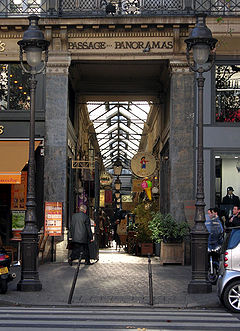
The 2nd arrondissement of Paris is one of the 20 arrondissements of the capital city of France. In spoken French, this arrondissement is colloquially referred to as deuxième. It is governed locally together with the 1st, 3rd and 4th arrondissement, with which it forms the 1st sector of Paris.
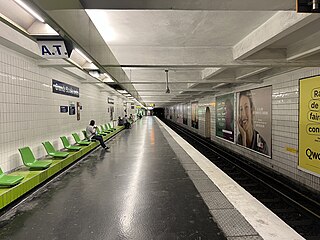
Grands Boulevards, formerly named Rue Montmartre (1931–1998), is a station on Lines 8 and 9 of the Paris Métro. In 2019, it was the 44th busiest station of the Métro network, with 6,807,424 yearly users.

The Musée Carnavalet in Paris is dedicated to the history of the city. The museum occupies two neighboring mansions: the Hôtel Carnavalet and the former Hôtel Le Peletier de Saint Fargeau. On the advice of Baron Haussmann, the civil servant who transformed Paris in the latter half of the 19th century, the Hôtel Carnavalet was purchased by the Municipal Council of Paris in 1866; it was opened to the public in 1880. By the latter part of the 20th century, the museum was full to capacity. The Hôtel Le Peletier de Saint Fargeau was annexed to the Carnavalet and opened to the public in 1989.

The following is a timeline of the history of the city of Paris, France.

This "quartier" of Paris got its name from the rue de la Chaussée-d'Antin in the 9th arrondissement of Paris. It runs north-northwest from the Boulevard des Italiens to the Église de la Sainte-Trinité.

Marguerite Brunet, known by her stage name of Mademoiselle Montansier, was a French actress and theatre director.

The Galerie Véro-Dodat is one of the covered passages of Paris. It is located in the 1st arrondissement, connecting the Rue de Jean-Jacques Rousseau and the Rue Croix-des-Petits-Champs. It was built in 1826.

The Galerie Vivienne is one of the covered passages of Paris, located in the 2nd arrondissement. It is 176 metres (577 ft) long and 3 metres (9.8 ft) wide. The gallery has been registered as a historical monument since 7 July 1974.

The Passage Jouffroy is one of the covered passages of Paris, located in the 9th arrondissement. It runs between the Boulevard Montmartre to the south and the Rue de la Grange-Batelière to the north.
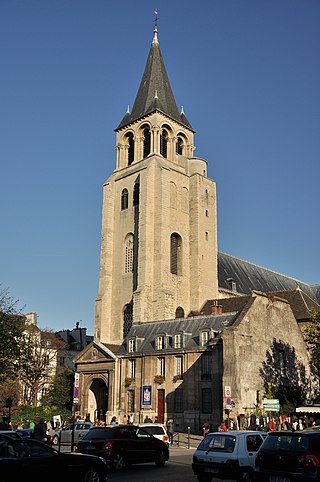
The city of Paris has notable examples of architecture of every period, from the Middle Ages to the 21st century. It was the birthplace of the Gothic style, and has important monuments of the French Renaissance, Classical revival, the Flamboyant style of the reign of Napoleon III, the Belle Époque, and the Art Nouveau style. The great Exposition Universelle (1889) and 1900 added Paris landmarks, including the Eiffel Tower and Grand Palais. In the 20th century, the Art Deco style of architecture first appeared in Paris, and Paris architects also influenced the postmodern architecture of the second half of the century.

The Boulevard Barbès is a boulevard in the 18th arrondissement of Paris. It is named after French politician Armand Barbès. It was built in 1867 during Haussmann's renovation of Paris. It starts at the boulevard de la Chapelle and ends at the rue Ordener. It is 835 metres long and 35 metres wide.

In the 10th century Paris was a provincial cathedral city of little political or economic significance, but under the kings of the Capetian dynasty who ruled France between 987 and 1328, it developed into an important commercial and religious center and the seat of the royal administration of the country. The Île de la Cité became the site of the royal palace and the new cathedral of Notre-Dame, begun in 1163. The Left Bank was occupied by important monasteries, including the Abbey of Saint-Germain-des-Prés and the Abbey of St Genevieve. In the late 1100s, the collection of colleges on the left bank became one of the leading universities in Europe. The Right Bank, where the ports, central markets, artisans and merchants were located, became the commercial center of the city, and the merchants assumed an important role in running the city. Paris became a center for the creation of illuminated manuscripts and the birthplace of Gothic architecture. Despite civil wars, the plague, and foreign occupation, Paris became the most populous city in the Western world during the Middle Ages.

First Consul Napoleon Bonaparte moved into the Tuileries Palace on 19 February 1800 and immediately began to re-establish calm and order after the years of uncertainty and terror of the Revolution. He made peace with the Catholic Church; masses were held again in the Cathedral of Notre Dame, priests were allowed to wear ecclesiastical clothing again, and churches to ring their bells. To re-establish order in the unruly city, he abolished the elected position of the Mayor of Paris, and replaced it with a Prefect of the Seine and a Prefect of Police, both appointed by him. Each of the twelve arrondissements had its own mayor, but their power was limited to enforcing the decrees of Napoleon's ministers.

During the Restoration of the Bourbon monarchy (1815–1830) that followed the downfall of Napoleon, Paris was ruled by a royal government which tried to reverse many of the changes made to the city during the French Revolution. The city grew in population from 713,966 in 1817 to 785,866 in 1831. During the period Parisians saw the first public transport system, the first gas street lights, and the first uniformed Paris policemen. In July 1830, a popular uprising in the streets of Paris brought down the Bourbon monarchy and began reign of a constitutional monarch, Louis-Philippe.

Paris during the reign of King Louis-Philippe (1830–1848) was the city described in the novels of Honoré de Balzac and Victor Hugo. Its population increased from 785,000 in 1831 to 1,053,000 in 1848, as the city grew to the north and west, while the poorest neighborhoods in the center became even more crowded.

Paris in the Belle Époque was a period in the history of the city between the years 1871 to 1914, from the beginning of the Third French Republic until the First World War. It saw the construction of the Eiffel Tower, the Paris Métro, the completion of the Paris Opera, and the beginning of the Basilica of Sacré-Cœur on Montmartre. Three lavish "universal expositions" in 1878, 1889, and 1900 brought millions of visitors to Paris to sample the latest innovations in commerce, art, and technology. Paris was the scene of the first public projection of a motion picture, and the birthplace of the Ballets Russes, Impressionism, and Modern Art.

The architecture of Paris created during the Belle Époque, between 1871 and the beginning of the First World War in 1914, was notable for its variety of different styles, from neo-Byzantine and neo-Gothic to classicism, Art Nouveau and Art Deco. It was also known for its lavish decoration and its imaginative use of both new and traditional materials, including iron, plate glass, colored tile and reinforced concrete. Notable buildings and structures of the period include the Eiffel Tower, the Grand Palais, the Théâtre des Champs-Élysées, the Gare de Lyon, the Bon Marché department store, and the entries of the stations of the Paris Metro designed by Hector Guimard.
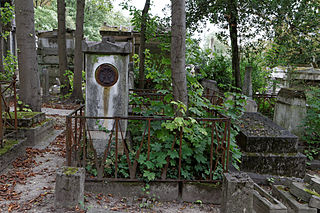
Jacques Cellerier (1742–1814) was a French architect in the neoclassical style whose buildings can be seen mainly in Paris and Dijon.
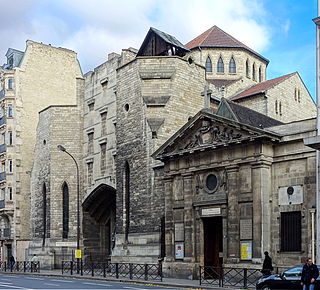
La Chapelle is a former commune of the Seine department, which existed from 1790 to 1860 before being incorporated into Paris. It was called "La Chapelle-Franciade" during the French Revolution. It is sometimes called "La Chapelle-Saint-Denis" or "La Chapelle-Sainte-Geneviève".
